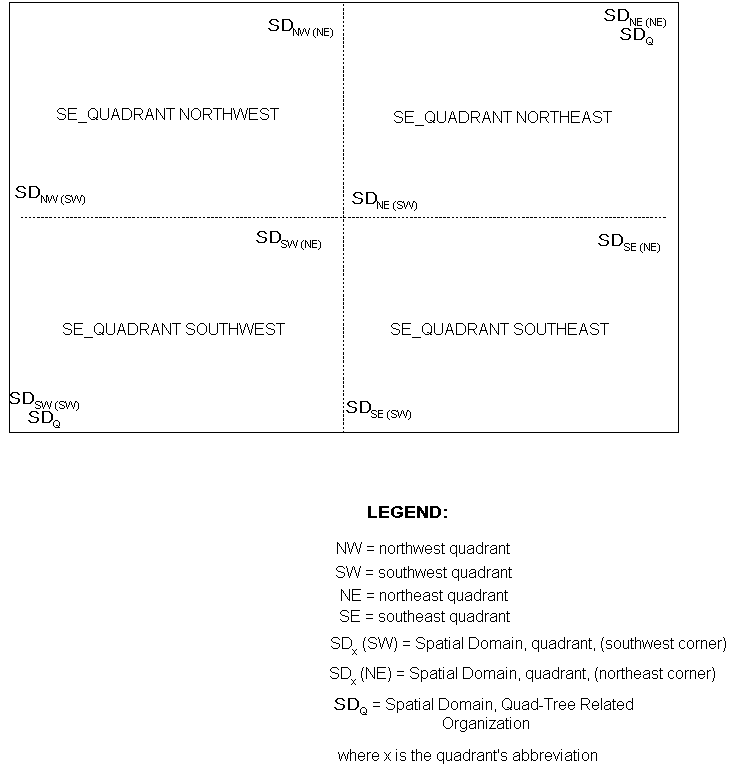Q shall have a <Spatial Extent> component.
Each branch of Q shall comply with the following constraints.
Each component representing a quadrant shall have a <Spatial Extent> component. In the case of quadrants represented by <Geometry Model Instance> instances or <Feature Model Instance> instances, the <Model> instance being referenced shall have the <Spatial Extent> component.
For each branch of Q, each primitive within the branch shall have a spatial extent fully contained within that specified by the <Spatial Extent> instance corresponding to the branch. Consequently, the unique_descendants field of Q shall be set to SE_TRUE, because no DRM object can be fully contained within the <Spatial Extent> instance of more than one branch of Q.
The regions defined by the branches shall not overlap; that is, the <Spatial Extent> components of the component hierarchies shall not overlap.
The four possible quadrant components' <Spatial Extent> components shall be defined in their native SRF within the area specified by the <Spatial Extent> component of Q as depicted in Figure 6.XXX.
Consider the bounding area defined by the <Spatial Extent> component of Q, as divided into four quadrants of equal size.
If a branch with SE_QUADRANT_LEFT_FRONT is present, its <Spatial Extent> component shall specify the area of the northwest quadrant, such that
2.3.1.1 its eastern boundary aligns with the western boundary of the <Spatial Extent> component of the SE_QUADRANT_RIGHT_FRONT quadrant, if present, and
2.3.1.2 its southern boundary aligns with the northern boundary of the <Spatial Extent> component of the SE_QUADRANT_LEFT_BACK quadrant, if present.
If a branch with SE_QUADRANT_RIGHT_FRONT is present, its <Spatial Extent> component shall specify the area of the northeast quadrant, such that
2.3.2.1 the <Location> instance representing its northeast corner corresponds to that of Q's <Spatial Extent> component,
2.3.2.2 its western boundary aligns with the eastern boundary of the SE_QUADRANT_LEFT_FRONT quadrant's <Spatial Extent> component, if present, and
2.3.2.3 its southern boundary aligns with the northern boundary of the SE_QUADRANT_RIGHT_BACK quadrant's <Spatial Extent> component, if present.
If a branch with SE_QUADRANT_LEFT_BACK is present, its <Spatial Extent> component shall specify the area of the southwest quadrant, such that
2.3.3.1 the <Location> instance representing its southwest corner corresponds to that of Q's <Spatial Extent> component,
2.3.3.2 its eastern boundary aligns with the western boundary of the SE_QUADRANT_RIGHT_BACK quadrant's <Spatial Extent> component, if present, and
2.3.3.3 its northern boundary aligns with the southern boundary of the SE_QUADRANT_LEFT_FRONT quadrant's <Spatial Extent> component, if present.
If a branch with SE_QUADRANT_RIGHT_BACK is present, its <Spatial Extent> component shall specify the area of the southeast quadrant, such that
2.3.4.1 its western boundary aligns with the eastern boundary of the SE_QUADRANT_LEFT_BACK quadrant's <Spatial Extent> component, if present, and
2.3.4.2 its northern boundary aligns with the southern boundary of the SE_QUADRANT_RIGHT_FRONT quadrant's <Spatial Extent> component, if present.
The strict_organizing_principle and unique_descendants field values of Q shall be SE_TRUE.
